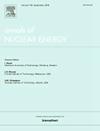Generalized Levermore–Pomraning equations with memory effects
IF 1.9
3区 工程技术
Q1 NUCLEAR SCIENCE & TECHNOLOGY
引用次数: 0
Abstract
The Levermore–Pomraning (LP) equations allow obtaining approximate solutions to particle transport problems in Markov media, reducing the computation time compared to reference solutions resulting from sampling a collection of material realizations and solving for each of them the linear transport equation. The deterministic LP equations have a stochastic counterpart, the Chord Length Sampling (CLS) model, which can be easily implemented in a Monte Carlo particle-transport solver with minimal modifications. It is known that significant discrepancies may appear between exact and LP (or CLS) solutions, because of the memory-less nature of the LP (or CLS) model. Over the years, several CLS-like improved models have been proposed: greater accuracy with respect to reference solutions has been achieved by adding ‘spatial memory’ effects to the stochastic particle-transport algorithms. In this work, we present an enhanced-memory deterministic LP model in one-dimensional geometry, obtained by introducing a mathematical formalism to take into account memory effects in the LP equations. We will benchmark our results against the standard LP and CLS models, the improved CLS-like models, and the reference solutions for a set of spatially heterogeneous configurations.
求助全文
约1分钟内获得全文
求助全文
来源期刊

Annals of Nuclear Energy
工程技术-核科学技术
CiteScore
4.30
自引率
21.10%
发文量
632
审稿时长
7.3 months
期刊介绍:
Annals of Nuclear Energy provides an international medium for the communication of original research, ideas and developments in all areas of the field of nuclear energy science and technology. Its scope embraces nuclear fuel reserves, fuel cycles and cost, materials, processing, system and component technology (fission only), design and optimization, direct conversion of nuclear energy sources, environmental control, reactor physics, heat transfer and fluid dynamics, structural analysis, fuel management, future developments, nuclear fuel and safety, nuclear aerosol, neutron physics, computer technology (both software and hardware), risk assessment, radioactive waste disposal and reactor thermal hydraulics. Papers submitted to Annals need to demonstrate a clear link to nuclear power generation/nuclear engineering. Papers which deal with pure nuclear physics, pure health physics, imaging, or attenuation and shielding properties of concretes and various geological materials are not within the scope of the journal. Also, papers that deal with policy or economics are not within the scope of the journal.
 求助内容:
求助内容: 应助结果提醒方式:
应助结果提醒方式:


